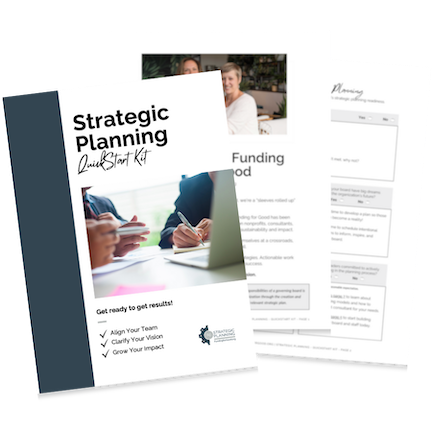“Our biggest problem is that our board isn’t active!“
Nonprofit leaders report that a handful of board members consistently do all the work.
In fact, “Only 33 percent of nonprofits report that their board members are actively involved in advocating for their missions” (BoardSource).
Before addressing how to engage board members, it is essential to explore the question: “Why are most board members unengaged? There are many potential responses; however, the following two realities contribute to passive board cultures.
- Boards fail to fill seats with the right community leaders.
According to the 2021 survey, almost half (49%) of all chief executives said that they did not have the right board members to “establish trust with the communities they serve.” (Leadingwithintent.org)
If board members do not have the trust of the communities they serve, their ability to achieve meaningful impact is significantly reduced. As leaders of a purpose-driven, board members want to know that their limited time is being used to bring about positive change. The disconnect from the very people they serve hinders viable solutions to community issues and direct engagement.
2. An ineffective onboarding process contributes to uninformed and unengaged board members.
“Only 12% of employees strongly agree their organization does a great job of onboarding new employees. That means 88% don’t believe their organizations do a great job of onboarding.” (https://www.saplinghr.com/10-employee-onboarding-statistics-you-must-know-in-2022)
The unwillingness or inability of board members to fully engage and follow through often leaves the Executive Director (ED) and chair with extensive last-minute to-do lists.
Engaging board members without overwhelming them or inviting chaos can be tricky.
It is essential to establish clear guidelines on appropriate ways for them to work with and represent the organization.
Here are five tips for keeping the board active and accountable.
- Engage the board in quality nonprofit leadership training opportunities.
All board members should receive education in the following areas:
-
- Understanding the roles and responsibilities of nonprofit board members
- Board building -includes identifying and onboarding members, succession planning, and increasing board engagement.
- Financial oversite- topics might range from budgeting basics to organization-specific fiscal policies and processes.
- Strategic planning- topics could range from “understanding the board’s role in planning processes” to “engaging in effective strategic planning.”
- Board’s choice- training topics should address specific areas of priority identified by current board leaders
- Ensure that Board Action Aligns with Strategic Plan Goals and Outcomes
A well-crafted strategic plan is the best way to ensure that the board and staff are unified in priorities and working in partnership to achieve approved goals. Statistically, having a written strategic plan doubles an organization’s chance for success. The most effective strategic planning processes fully engage decision-makers at the board, staff, and stakeholder levels.
Rather than offer “cookie-cutter” engagement options, frame board engagement opportunities through the lens of challenges the board can help the organization overcome or goals the board can help achieve.
For example:
Frame a goal: “Our goal is to diversify our board’s leadership within the next 12 months.
Invite board members to explore ways to engage: How might each of you like to contribute to achieving this goal at an individual/committee level over the next __months?
Secure board commitment to specific tasks and timelines: “Of the strategies we explored, which ones are we committed to implementing? Who will spearhead each action item? Who will assist? What follow-up and evaluation measures should we use to ensure Accountability?
- Establish Effective Communication Between the Board Chair and Executive Director
Some nonprofit pros have compared the board chair and executive director relationship to twin engines on a plane. This image reminds us that the Board Chair and Executive Director must be working in complete balance and harmony. When one engine fails, the entire plane can go down.
When communication breaks down at the leadership level, the entire organization is at risk.
Yes, the Executive Director should be offering regular reports/updates to the board at regularly scheduled meetings. However, the Board Chair is the first point of contact for critical communication and preparing to present action items to the executive committee and the entire board.
- Equip Board Members with Engagement Kits
A chief complaint of board members is that they are NOT as active as they would like to be because no one has given them anything specific to do. This forces board members to become passive or prompts them to “go rogue” and invent ways to support the organization. A few ways the ED and board chair can include:
-
- The ED should work with program staff to outline straightforward ways that board members can engage in the day-to-day activities.
- The ED can include a “Top five ways to engage” section in each report submitted for board review.
- The board chair and committee chairs should work with the Executive Director to outline tasks that committees can address.
- The ED and chair can equip the board and staff to utilize team management software. These systems allow leaders to assign tasks, track progress, and share impact reports with the team.
- Evaluate and Maintain Accountability
Performance reviews are common in the workplace, but nonprofits often overlook regular evaluations. Most board chairs and EDs are uncomfortable evaluating the board’s performance or demanding accountability because board members are “volunteers” who “don’t have to be here.” Every board should conduct annual performance reviews on both the board and ED. Just as the board evaluates the ED’s performance, it is helpful to gain the staff’s perspective on how the board is performing.


